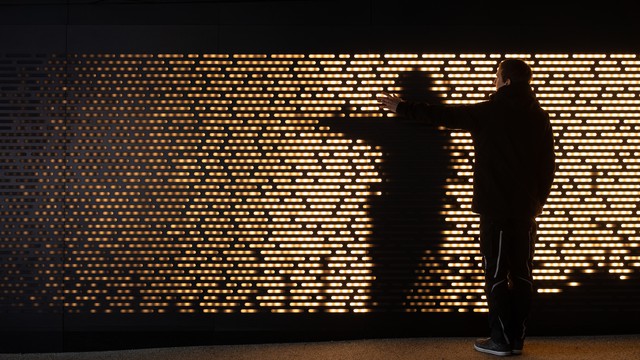Shadow Wall 2019, United Kingdom, London
Playful media art installation encouraging people to dance with their shadow



A high-tech, permanent public art installation that instigates public participation and sparks the imagination.
In 2018, Quintain instructed Jason Bruges Studio (JBS) to create an uplifting intervention for the ‘Royal Route’ underpass in Wembley Park. Taking inspiration from the everchanging flow of people passing by, JBS proposed a digital intervention that references the past, when the Royal Family arrived in procession, and amplifies the present circulation of pedestrians. Integrated into the eastern elevation of the underpass Shadow Wall, uses a bespoke system of infrared light sensors to reveal people’s silhouettes. As crowds approach the site their individual actions are captured and immediately played back via custom printed circuit boards (PCBs) that have been specifically developed by JBS for use inside the artwork. Each individual LED/sensor node across the surface of the underpass works autonomously, both sensing and emitting light simultaneously. Individuals are confronted with their digital counterpart. They’re encouraged to dance with their shadow and in turn with each other. In doing so, they create a dynamic palimpsest of overlaying figures. Emphasis has been placed on horizontal movement, which is seen in the carefully crafted diffusers that use an elongated oval shape to ‘stretch’ the light and amplify forward and backward motion. This, coupled with a decision to lengthen the time it takes for each image to degrade, adds to the dynamism of the piece and responds to Wembley Park’s association with sports and athletics. The effect is most evident when people run past the artwork and a visible trace of their motion lingers, painted in light. To ensure artwork performs appropriately at different times of day and under different conditions, JBS have developed a unique system that allows them to gather data locally and respond accordingly. The PCBs have been engineered to take readings of the infrared light levels and feed this back to a computer. This is then processed using a gaming engine called Unity that in turn determines how the artwork should function in response. For example, when either no one is directly interacting with the artwork or if swathes of people are passing by, Shadow Wall plays back ‘remembered’ images so the visual effect is still readable and impactful.
Details
Building or project owner : Quintain
Project artist/ concept/ design/ planning : Jason Bruges Studio
Descriptions
Participatory architecture & urban interaction
Mediacredits
Jason Bruges Studio
Jason Bruges Studio
Jason Bruges Studio
Jason Bruges Studio